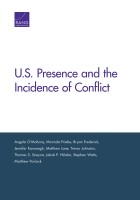| 来源类型 | Research Reports
|
| 规范类型 | 报告
|
| DOI | https://doi.org/10.7249/RR1906
|
| ISBN | 9780833097972
|
| 来源ID | RR-1906-A
|
| U.S. Presence and the Incidence of Conflict |
| Angela O'Mahony; Miranda Priebe; Bryan Frederick; Jennifer Kavanagh; Matthew Lane; Trevor Johnston; Thomas S. Szayna; Jakub P. Hlavka; Stephen Watts; Matthew Povlock
|
| 发表日期 | 2018
|
| 出版年 | 2018
|
| 页码 | 152
|
| 语种 | 英语
|
| 结论 |
The Effects of U.S. Troop Presence on Interstate Conflict- On average, nearby U.S. troop presence is associated with a lower likelihood of interstate war.
- Nearby U.S. troop presence is associated with allies initiating fewer militarized disputes.
- These benefits appear to come with tradeoffs. Nearby U.S. troop presence is associated with a higher likelihood of low-intensity militarized disputes (e.g., displays of military force and threats to use military force).
- In addition, a large in-country U.S. troop presence is associated with potential U.S. adversaries initiating even higher-intensity militarized disputes, though still short of war.
- U.S. troop presence is associated with a higher likelihood of the United States initiating militarized disputes. This may reflect the strategic deployment of U.S. forces near states with which the United States expects to engage in military conflict.
The Effects of U.S. Military Presence on Intrastate Conflict- The authors found no consistent or robust association between U.S. forward troop presence and intrastate conflict.
- However, overall U.S. military assistance is positively associated with an increased risk of anti-regime activities and greater levels of state repression by incumbent governments.
The Effects of U.S. Military Assistance on Conflict- The authors found no consistent or robust association between U.S. military assistance and interstate conflict.
- However, provision of U.S. military assistance may be associated with increased state repression and incidence of civil war.
Implications for Forward Presence Decisions- A large U.S. regional troop presence can be an effective tool in deterring interstate war, but it may also provoke more militarized activities short of war.
- With regard to U.S. efforts to deter Russia and China, the authors note that substantial nearby U.S. troop presence may in general be associated with a lower likelihood of interstate war, though it may increase the risk of provocations short of war, and these general patterns might differ in specific cases.
- U.S. military assistance, much of which has historically been in the Middle East, may overall be associated with a greater likelihood of repression or domestic instability, though the effects may differ in particular countries.
|
| 主题 | Low-Intensity Conflict
; Military Force Deployment
; Security Cooperation
; United States
; United States Army
|
| URL | https://www.rand.org/pubs/research_reports/RR1906.html
|
| 来源智库 | RAND Corporation (United States)
|
| 引用统计 |
|
| 资源类型 | 智库出版物
|
| 条目标识符 | http://119.78.100.153/handle/2XGU8XDN/108728
|
推荐引用方式
GB/T 7714 |
Angela O'Mahony,Miranda Priebe,Bryan Frederick,et al. U.S. Presence and the Incidence of Conflict. 2018.
|
|
文件名:
|
x1518726717266.jpg
|
|
格式:
|
JPEG
|

|
文件名:
|
RAND_RR1906.pdf
|
|
格式:
|
Adobe PDF
|
除非特别说明,本系统中所有内容都受版权保护,并保留所有权利。